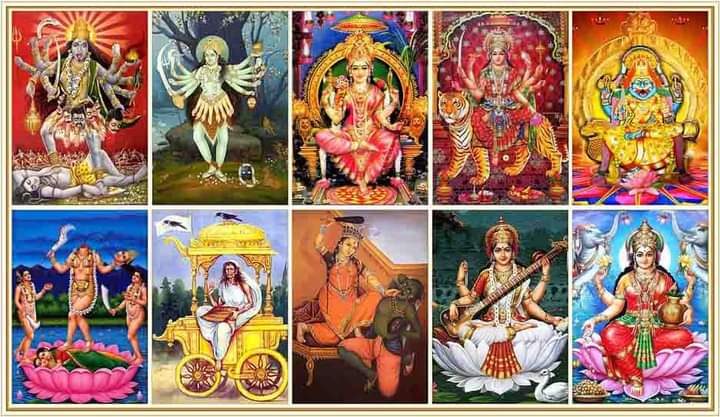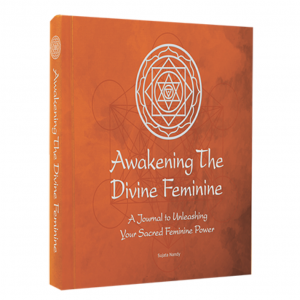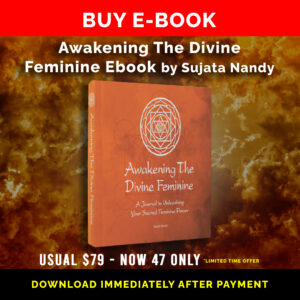Shaktas (worshippers of Shakti), believe, “the one Truth is sensed in ten different facets; the Divine Mother is adored and approached as ten cosmic personalities,” the Dasa-Mahavidya.
The Das Mahavidya symbolize diverse characteristics of divinity devoted to guiding the spiritual seeker towards liberation. For the devotionally minded seeker, these manifests can be approached in a spirit of loyalty, respect, love and increasing affection. For a knowledge-oriented seeker, these same manifests can describe copious states of inner awakening along the path to enlightenment.
The Das Mahavidya are Wisdom Goddesses: ‘Das,’ means ten, ‘maha,’ means great, and ‘vidya,’ means wisdom. The Das Mahavidya are believed to be forms of Divine Mother Kali, who is the first of the Mahavidya. Each Wisdom Goddess has Her own name, story, quality, and mantras. They are all avatars of Goddess Parvati and They are: KALI, TARA, TRIPURA SUNDARI (or Shodashi), BHUVANESWARI, CHINNAMASTA, DHUMAVATI, BAGALAMUKHI, MATANGI and KAMALA.
The Das Mahavidyas is an extensive piece of work with deep tantric rituals and practices that takes lifetimes to master yet, it is the intrinsic key to all understanding of Shakti and the wisdom of the Goddess. It is believed that the Das Mahavidya affords the landscape for the blank canvas that is the sadhak (ardent devotee), providing all the tools of understanding every spectrum of the Devi.
KALI
Kali, the first and chief Goddess of the Das Mahavidya, symbolizes the power of consciousness in its highest form. She is the supreme power and the ultimate reality, accentuating the vital Tantric thinking that the power of consciousness and consciousness itself are one and the same.
From the Absolute to the relative, Kali epitomizes the power of transformation, holding out the promise to transform us from mere mortals to divine beings; lifting us from the abyss of our own web of destruction and delivering us to the path, we find alignment in.
TARA
Second to Kali in the Das Mahavidya ranking is Tara who resembles Kali in a myriad of ways. Prominent both in Tibetan Buddhism and in Tantric Hinduism, Tara’s many qualities include forms that are either peaceable (saumya) or ferocious (ugra). Tara’s name is derived from ‘tri,’ which means “to cross,” which lends the perspective of one of Her names: ‘Samsaratarini,’ which literally means, “She who takes across the ocean of worldly existence.” Tara is thus the all-gracious saviour.
So close are the depictions of Tara and Kali that often Their individualities blur. Both Kali and Tara are profoundly associated with death and dissolution. While Kali is often said to be the force of time (kala), that inexorably causes all constructed things to perish, Tara is more often linked with fire, especially the fires of the cremation grounds, hence why, one of Her names is Smasanabhairavi, “the terrible one of the cremation grounds.” It is imperative to keep in mind that fire symbolizes not only destruction but also purification and transformation.
TRIPURASUNDARI
Tripurasundari is often mentioned as an adimahavidya, or the primordial wisdom goddess, which puts Her in the company of Kali and Tara as symbolizing one of the final encounters of reality. She is not the ultimate, absolute, or ‘nirguna,’ state deprived of all attributes; still, She symbolizes the understanding of consciousness in a high state of divine universality.
From an etymological point of view, “tri,” means Three, and “pura,” means city, or citadel. Thus, Tripura may be interpreted as “the one comprising all three citadels,” suggesting to the three worlds of God’s creation: the physical world, the astral world and the causal world.
Tripurasundari represents the state of awareness that is also called the sadasivatattva, which is described as “I am this,” (aham idam).
Tripura Sundari is also known as Lalita, “the one who plays.” The Hindu spiritual tradition maintains that the whole Creation is in fact the beautiful, charming game, or the play of the Divine Mother.
Tripura Sundar’s sadhana (practice) is therefore the purification of our awareness—cleansing the mind of undeserving thoughts and the patterns of thinking that provoke them, recognising beauty everywhere, seeing the extraordinary in the routine, and escalating to the belief that nothing is alien to ourselves. As the Upanishads teach, “All this universe is truly Brahman,” (sarvam khalv idam brahma); so too is this Self (ayam atma brahma).
BHUVANESVARI
The fourth Mahavidya is Bhuvanesvari, whose form bears semblance to that of Tripurasundari. Even more than the goddess who is beautiful in the three worlds or surpasses them, Bhuvanesvari is classified with the manifest world and our experience of it.
Her name consists of two elements: ‘bhuvana,’ which means this living world—a place of dynamic activity—and ‘isvari,’ which means the female ruler or sovereign. The name Bhuvanesvari is most often construed as “Mistress of the World,” but ‘bhuvana,’ is more than the earth we stand upon. It is the entire cosmos, the ‘bhuvanatraya,’ encompassing the heavens, the atmosphere, and the earth.
Essentially, Bhuvanesvari, by Her ubiquity and relationship with the Universe, inspires us to cultivate a mentality of universality. Any religion which lay claim on obtaining the absolute truth is pandering in precarious delusion. All religions connect humanity to a single reality that lies beyond this world of our trivial disparities yet abides in every heart and mind. Some choose to call this reality God or Heavenly Father or Divine Mother, but in truth He, She, or It is that which cannot be named, for to name is to limit the Illimitable.
CHINNAMASTA
Chinnamasta (She who is decapitated), is a form of the Divine Mother shown as having cut off Her own head. The blood that spurts from Her neck flows in three streams—one into Her own mouth and the others into the mouths of Her two female attendants, Dakini and Varnini. At the same time, Chinnamasta stands on the body of another female figure who is copulating with a male who lies beneath Her.
Chinnamasta’s representation conveys to us the message of eradicating ourselves of wrong ideas and the limitations inflicted on us by ignorance of our true nature. From the yogic spiritual tradition, the condition of the headless state represents in fact our true inner nature, of the divine and perfectly detached witness.
Symbolically speaking, Chinnamasta is the head that chews on the entire body, being thus the power of destruction and transformation of the manifested reality into the non-manifested, original reality.
BHAIRAVI
The name Bhairavi means “frightful,” “terrible,” “horrible,” or “formidable.” From an etymologic point of view, the name Bhairavi comes from three groups of letters, with a precise semantics: ‘bha,’ symbolizes the act of preservation, in the sense of continuousness, ‘ra,’ signifies ‘ramana,’ the creative divine activity and ‘va,’ coming from ‘vamana,’ denoting to the relaxation or concluding a certain activity.
A powerful analogical depiction of the Great Cosmic Wisdom Bhairavi is materialized in a woman’s anger, of even more concretely, in the swift, firm, and defined actions of a mother protecting her children against an exterior threat.
Though Bhairavi can be unsettling or even terrifying, She is ultimately the embodiment of benevolence. Again, we are reminded that She is the colour of fire, which burns and annihilates at the physical level and yet, transformative in a spiritual level.
It is often said that Bhairavi epitomizes divine wrath, but it is only an impulse of Her fierce, maternal protectiveness, directed at the destruction of ignorance and everything negative that keeps us in bondage. In that aspect, She is called Sakalasiddhibhairavi, the granter of every perfection.
DHUMAVATI
If Bhairavi signifies irresistible brilliance, Dhumavati epitomizes the dark side of life. We know from our own experience that life can be exciting, wonderful, and enjoyable—something we want to embrace and live to the fullest. But that same life can also turn to become sorrowful, depressing, and frustrating. At such moments we respond with cynicism, anxiety, or anger. It is then that we no longer want to embrace life but rather to avoid its misery.
This is where Dhumavati comes in. Her name means “She who is made of smoke,” – the residual effects of fire. It is dark, damaging and suppressing, illustrative of the worst facets of human existence. The concepts embodied in Dhumavati are very ancient, and they have to do with keeping life’s inevitable suffering at bay.
The image of Dhumavati, old, ugly, alone and miserable in Her cart of disempowerment, tells us to nurture a sense of detachment. Note that Dhumavati holds a bowl of fire in one hand and a winnowing basket in the other. The fire symbolizes predictable cosmic destruction: all things shall perish. The winnowing basket, used to separate grain from chaff, represents ‘viveka,’ mental discrimination between the permanent and the fleeting. Even though Her stalled cart represents an external life going nowhere, Dhumavati empowers us inwardly to reach for the highest, and there is nothing to stop us once we are resolved. In the end, She points the way to liberation.
BAGALAMUKHI
Of all the Mahavidya, Bagalamukhi is the most elusive. Her symbology varies widely, and its interpretation shows little consistency. Etymologically, Bagala means “rope,” or “rein,” and Mukhi means “face,” or “image.” Therefore, Bagalamukhi is the Goddess whose face has the formidable power (through Her subtle radiation), to control or to rule any situation or form in manifestation.
Bagalamukhi is consistently associated with siddhis which are yogic powers with magical properties. For a genuine spiritual aspirant, such powers are obstacles to be avoided.
In the tantric pantheon, Bagalamukhi is considered the leader of the “army,” consisting of all goddesses (actually, this is the “army,” of the Supreme manifested Energy (Shakti) that actually belongs to Shiva ) and She is its terrible and instantaneous force.
The Great Goddess represents the “terrible sceptre of Divine judgement,” of man’s evil actions and She also represents the extraordinary power of focusing one’s attention thus the eliminating any possible confusion. Various yogic texts and manuscripts highlight Her incredible power to induce a state of stoppage, an utterly “paralyzing,” state, of any kind of action.
MATANGI
At first glance, Matangi looks very much like Sarasvati. The main point of similarity is the ‘vina,’ (musical instrument) that She plays. Like Sarasvati, She holds a book and a japa mala as well. Together these symbolize the interrelated aspects of sound, knowledge, and power.
The sound of the vina signifies creativity, which is the power of consciousness to express itself. The mala also symbolizes the power of sound, but in the form of the mantra. The book stands for the wisdom and knowledge conveyed through the word. The parrot that accompanies Matangi also has associations with speech.
Like Bagalamukhi, Matangi is often associated with yogic or magical powers that can be invoked to exert influence over our environment or over other people.
In Tantric teaching the word for impurity is ‘mala.’ Mala arises through the atman’s association with maya, the Divine’s own power of limitation. The imperfect finite soul is only a contracted form of the perfect, infinite Self. Mala is the impurity of our finitude, and it takes three forms. Our actions are never free and spontaneous; they always bow to the conditioning that binds us, and their effects in turn prolong the bondage.
As long as the malas colour our awareness, they hold us captive. As long as we chase the conventional notions of purity and piety and shun their opposites, we are caught up in a reactive chain. Matangi’s example teaches us to face our false notions head on and to be free.
KAMALA
The ten Mahavidyas begins with Kali and ends with Kamala, portrayed as making the gestures of boon-giving and fearlessness. She sits on a lotus flower and holds lotus blossoms in Her two upper hands. Even Her name means “lotus.” She is flanked by two elephants. Obviously, Kamala is Lakshmi, who is portrayed in the identical manner, but in the context of the Mahavidya, there are also significant differences.
Kamala is not a divine consort but the independent and all-supreme Divine Mother. She is not the spouse of any male deity. Interestingly, She is rarely identified with the other female forms found in orthodox Vaisnavism, such as Sita, Radha, or Rukmini. Like Kali, the Tantric Kamala embraces the light and the darkness, for She is the totality.
These tantric Avatars of the sacred feminine are states of spiritual awakening that we experience within our own minds and hearts along the course of our journey back to the Divine. How often we’ve heard it said that God is love. Lakshmi or Kamala represents that love. To be saturated with the presence of Kamala is to become an embodiment of divine love. Then we come to understand Her great secret: love is unique and unlike anything else, for the more of it you give, the more of it you have. And with this great secret Kamala offers us a direct path to the Divine.
JAI MAA!
SUJATA NANDY WORLD GURUKUL
www.sujatanandy.com







